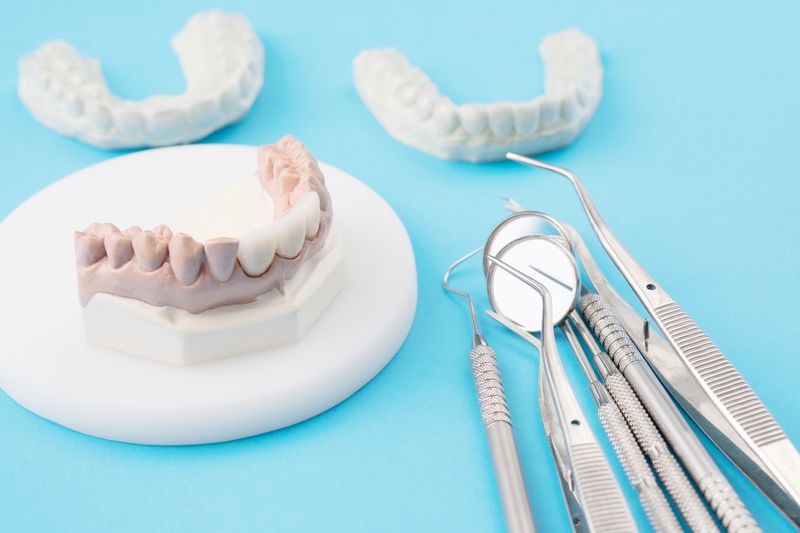
Maintaining good oral hygiene is crucial for the longevity and health of your dental bridges. Regular cleaning not only keeps them looking their best but also prevents plaque buildup and potential gum issues. So, let’s start with the basics, how to clean under dental bridges. First, you’ll need a soft-bristle toothbrush and dental floss. Gently brush your dental bridges, making sure to reach all the surfaces. Pay special attention to the areas where the bridge meets your natural teeth. Use a gentle, circular motion to remove any food particles or plaque. Don’t forget to floss between the bridge and your gums to remove any debris that may have accumulated. Remember, a little extra effort in cleaning your dental bridges can go a long way in maintaining a healthy and confident smile!
Cleaning dental bridges is crucial for maintaining oral hygiene. Here’s a step-by-step guide on how to clean them effectively:
- Start by rinsing your mouth with an antiseptic mouthwash to remove any loose debris.
- Use a soft-bristled toothbrush and fluoridated toothpaste to gently brush the bridge and surrounding teeth.
- Don’t forget to clean the spaces between the bridge and gums using floss or interdental brushes.
- Rinse your mouth thoroughly to remove any remaining toothpaste or debris.
- Consider using an antimicrobial mouthwash to further reduce bacteria buildup.
Regular cleaning of dental bridges will help maintain their longevity and prevent oral health issues. Remember to consult your dentist for personalized advice.

How to Clean Dental Bridges?
Dental bridges are a popular solution for replacing missing teeth. They are fixed prosthetic devices that are cemented onto existing teeth or dental implants. While dental bridges can restore the appearance and functionality of your smile, it is important to properly clean and maintain them to ensure their longevity and prevent oral health issues. In this article, we will discuss effective techniques and tips on how to clean dental bridges.
Why is Cleaning Dental Bridges Important?
Properly cleaning dental bridges is crucial for maintaining good oral hygiene. If dental bridges are not cleaned regularly, plaque and bacteria can accumulate around them, leading to gum disease and tooth decay. Additionally, food particles can get trapped between the bridge and the gums, causing bad breath and discomfort. By implementing a regular cleaning routine, you can prevent these issues and keep your dental bridges in optimal condition.
Tools and Techniques for Cleaning Dental Bridges
To clean dental bridges effectively, you will need a few essential tools. These include a soft-bristle toothbrush, dental floss, interdental brushes, and an antibacterial mouthwash. Here is a step-by-step guide on how to clean dental bridges:
1. Brushing: Start by gently brushing the dental bridge using a soft-bristle toothbrush. Make sure to clean all surfaces, including the areas where the bridge meets the gums. Use circular motions and be gentle to avoid damaging the bridge or causing discomfort.
2. Flossing: Dental floss is essential for removing plaque and food particles from between the teeth and under the bridge. Slide the floss carefully between the teeth and move it up and down to clean the sides of the bridge. Be gentle to avoid snapping the floss or dislodging the bridge.
3. Interdental Brushes: Interdental brushes are small brushes designed to clean between teeth and around dental work. Use an interdental brush to reach areas that are difficult to clean with a toothbrush or floss. Gently insert the brush between the teeth and move it back and forth to remove debris.
4. Mouthwash: Rinse your mouth with an antibacterial mouthwash to kill bacteria and freshen your breath. Swish the mouthwash around your mouth for 30 seconds, making sure to reach all areas, including the dental bridge.
Tips for Maintaining Clean Dental Bridges
In addition to regular cleaning, there are several tips you can follow to maintain clean dental bridges:
1. Avoid sticky and hard foods: Sticky and hard foods can dislodge or damage dental bridges. Try to avoid chewing on ice, hard candies, or sticky foods like caramel to prevent any accidents or damage.
2. Schedule regular dental check-ups: Regular dental check-ups are essential for ensuring the health and longevity of your dental bridges. Your dentist can professionally clean your bridges and check for any signs of damage or issues.
3. Use a water flosser: A water flosser can be a useful tool for cleaning hard-to-reach areas around dental bridges. The high-pressure water stream can effectively remove plaque and debris without causing discomfort.
4. Avoid smoking: Smoking can stain dental bridges and increase the risk of gum disease. Quitting smoking or avoiding tobacco products can help keep your bridges clean and prevent oral health issues.
By following these tips and incorporating regular cleaning into your oral hygiene routine, you can keep your dental bridges clean and maintain good oral health. Remember, proper care and maintenance are essential for the longevity and functionality of your dental bridges.
Key Takeaways: How to Clean Dental Bridges?
- Brush your dental bridge gently with a soft-bristled toothbrush.
- Use a bridge threader to clean underneath the bridge.
- Consider using an antimicrobial mouthwash to reduce plaque buildup.
- Floss carefully around the dental bridge to remove food particles.
- Visit your dentist regularly for professional cleanings and check-ups.
Frequently Asked Questions
Q: Why is it important to clean dental bridges regularly?
Regular cleaning of dental bridges is essential to maintain good oral hygiene and prevent dental issues. Dental bridges are prone to plaque and bacteria buildup, which can lead to gum disease, tooth decay, and bad breath. By cleaning your dental bridges regularly, you can remove food particles, bacteria, and plaque, ensuring the longevity and health of your bridges and surrounding teeth.
Moreover, maintaining clean dental bridges also helps in preventing staining and discoloration, keeping your smile bright and attractive. It is important to incorporate proper dental care habits, including regular cleaning, to avoid costly dental procedures and maintain optimal oral health.
Q: How often should I clean my dental bridges?
It is recommended to clean your dental bridges at least twice a day, just like your natural teeth. Brushing your bridges in the morning and before bed helps remove plaque and bacteria that accumulate throughout the day. Use a soft-bristle toothbrush and toothpaste specifically designed for bridges or recommended by your dentist.
In addition to brushing, it is crucial to floss between your dental bridges and adjacent teeth to remove any trapped food particles or debris. Regular flossing helps prevent gum disease and maintains the cleanliness of your bridges. Additionally, consider using an antimicrobial mouthwash to rinse your mouth, as it can help kill bacteria and freshen your breath.
Q: What is the proper technique for cleaning dental bridges?
To clean your dental bridges effectively, start by rinsing your mouth with water to remove any loose debris. Then, use a soft-bristle toothbrush and apply a pea-sized amount of toothpaste to the brush. Gently brush the bridges, focusing on the areas where the bridges meet the gums and adjacent teeth.
Ensure that you brush all surfaces of the bridges, including the front, back, and chewing surfaces. Use small, circular motions and gentle pressure to avoid damaging the bridges or irritating the gums. After brushing, thoroughly rinse your mouth with water to remove any remaining toothpaste or debris.
Q: Are there any special tools or products for cleaning dental bridges?
While regular toothbrushes and toothpaste can effectively clean dental bridges, there are specialized tools and products that can enhance the cleaning process. Interdental brushes, also known as proxy brushes, are small brushes designed to clean between teeth and bridges.
You can also use floss threaders or water flossers to clean hard-to-reach areas around your dental bridges. These tools help remove plaque and debris from the gaps between the bridges and adjacent teeth. Additionally, consider using antimicrobial mouthwash to further eliminate bacteria and maintain oral health.
Q: Can I use denture cleaners or whitening products on my dental bridges?
No, it is not recommended to use denture cleaners or whitening products on dental bridges. Denture cleaners may contain harsh chemicals that can damage the material of the bridges or cause discoloration. Whitening products, such as whitening toothpaste or strips, are designed for natural teeth and may not be effective on bridges.
If you are concerned about the color or appearance of your dental bridges, consult your dentist for professional advice. They can recommend safe and appropriate methods to whiten or improve the aesthetics of your bridges without causing any damage.
How to Clean a Dental Bridge with a Floss Threader
Final Summary: Keep Your Dental Bridges Sparkling Clean!
Call or Book appointment online
:Ace Dental Care Alpharetta office: 678-562-1555 - Book Now
Ace Dental Care Norcross office: 770-806-1255 - Book Now
Disclaimer
This blog post was generated by artificial intelligence. The content of this post may not be accurate or complete, and should not be relied upon as a substitute for professional advice. If you have any questions about the content of this post, please contact us.
We are constantly working to improve the accuracy and quality of our AI-generated content. However, there may still be errors or inaccuracies. We apologize for any inconvenience this may cause.





